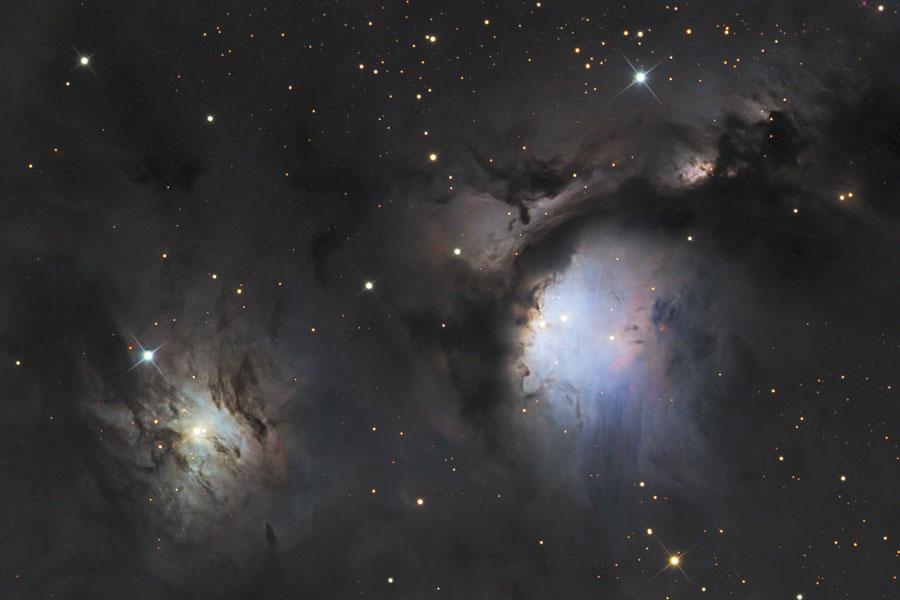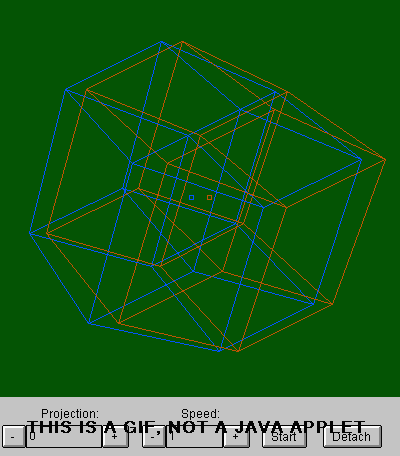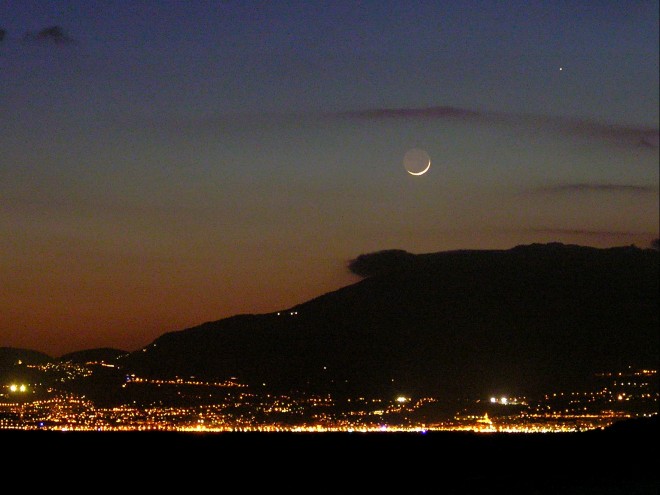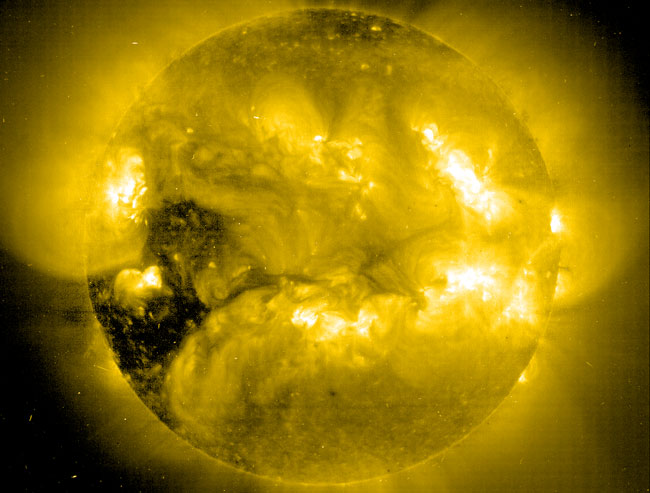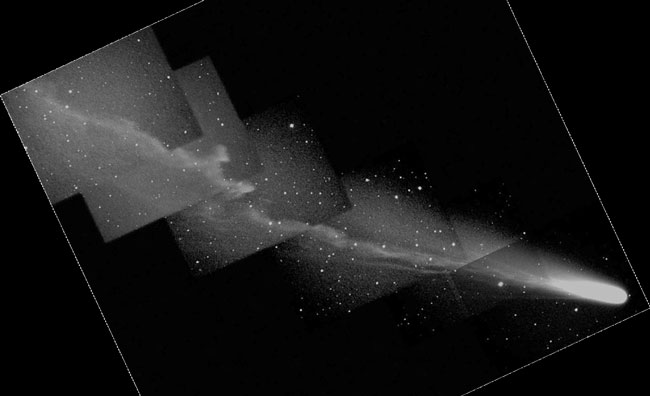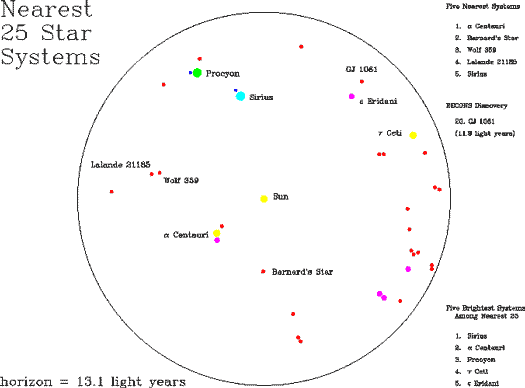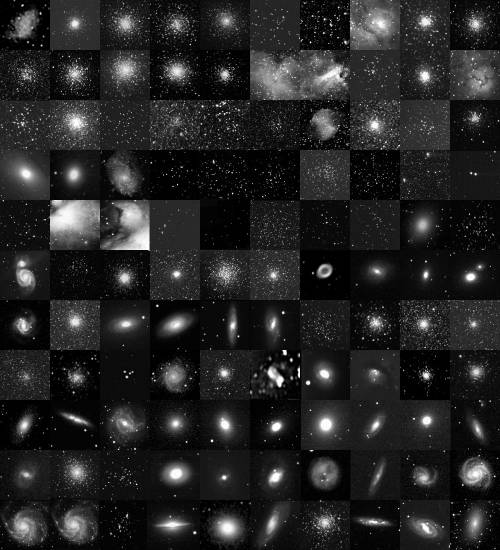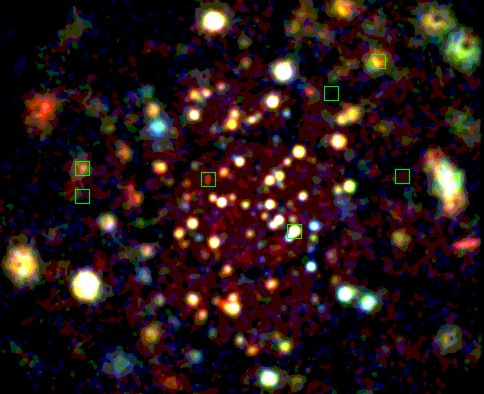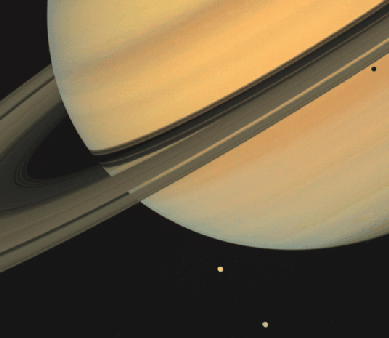| << Previous | Index | Next >> |
2015 What does the Earth look like during a total solar eclipse? It appears dark in the region where people see the eclipse, because that's where the shadow of the Moon falls. The shadow spot actually shoots across the Earth at nearly 2,000 kilometers per hour, darkening locations in its path for only a few minutes before moving on. The featured image shows the Earth during the total solar eclipse of 2006 March, as seen from the International Space Station. On Friday the Moon will move in front of the Sun once again, casting another distorted circular shadow that, this time, will zip over part of the north Atlantic Ocean.
2014 Did the universe undergo an early epoch of extremely rapid expansion? Such an inflationary epoch has been postulated to explain several puzzling cosmic attributes such as why our universe looks similar in opposite directions. Yesterday, results were released showing an expected signal of unexpected strength, bolstering a prediction of inflation that specific patterns of polarization should exist in cosmic microwave background radiation -- light emitted 13.8 billion years ago as the universe first became transparent. Called B-mode polarizations, these early swirling patterns can be directly attributed to squeeze and stretch effects that gravitational radiation has on photon-emitting electrons. The surprising results were discovered in data from the Background Imaging of Cosmic Extragalactic Polarization 2 (BICEP2) microwave observatory near the South Pole. BICEP2 is the building-mounted dish pictured above on the left. Note how the black polarization vectors appear to swirl around the colored temperature peaks on the inset microwave sky map. Although statistically compelling, the conclusions will likely remain controversial while confirmation attempts are made with independent observations.
2013 Have you seen the comet? As Comet PANSTARRS fades, careful observers -- even with unaided eyes -- should still be able to find the shedding ice ball on the western horizon just after sunset. Pictured above, Comet PANSTARRS (C/2011 L4) was pointed out from a hilltop last week on First Encounter Beach in Massachusetts, USA. The comet was discovered by -- and is named for -- the Pan-STARRS astronomical sky survey that discovered it. As the comet now recedes from both the Earth and the Sun, it will remain visible further into the night, although binoculars or a small telescope will soon to be needed to find it.
2012 It was visible around the world. The sunset conjunction of Jupiter and Venus was visible last week almost no matter where you lived on Earth. Anyone on the planet with a clear western horizon at sunset could see them. This week the two are still notable, even though Jupiter has sunk below the brighter Venus. And if you look higher in the sky you can see Mars as well. Pictured above, a creative photographer traveled away from the town lights of Szubin, Poland to image a near closest approach of the two planets almost a week ago. The bright planets were separated only by three degrees and his daughter striking a humorous pose. A faint red sunset still glowed in the background. Although this conjunction is drawing to a close, another conjunction between Venus and Jupiter will occur next May.
2011 When warm sunset hues begin to fade, two celestial beacons now shine in the evening twilight, Mercury and Jupiter. Wandering away from the Sun in planet Earth's sky, Mercury will offer good views this month as spring approaches in the northern hemisphere where the ecliptic plane makes a steep angle with the western horizon. But Jupiter will continue sinking lower in the sky after sunset. In fact, the normally elusive Mercury shines well above Jupiter and the orange sunset glow in this serene sky. Captured earlier this week from the island of of Frösön in northern Sweden, the scene looks across Lake Storsjön toward the village of Hallen and distant mountains. Of course, even better views of Mercury can be had by the MESSENGER spacecraft, now orbiting the Solar System's innermost planet!
2010
[imghover6=http://apod.nasa.gov/image/1003/Fermi1FGLsky.jpg]http://apod.nasa.gov/apod/image/1003/Fe ... ources.jpg[/imghover6]Credit: NASA, DOE, International Fermi LAT Collaboration
2009 How many stars can you see? Through next week, the GLOBE at Night project invites people from all over the world to go outside at night, look up, and see! Specifically, people are invited to go out an hour after sunset and look for the constellation Orion toward the west. Rather than count Orion's stars directly, however, the GLOBE at Night website has made things easier by providing several star charts to which you can compare your view of Orion. Possible matches extend from a bright sky where only a few Orion stars are visible, to a very dark sky where over 100 Orion stars are visible. Pictured above are results from last year's sky observation campaign. Since 2009 is the International Year of Astronomy, it is hoped that an even better map can be created this year. By participating in this easy and fun activity, you are helping humanity to better understand how light pollution is changing across the Earth.
2008 An eerie blue glow and ominous columns of dark dust highlight M78 and other bright reflection nebula in the constellation of Orion. The dark filamentary dust not only absorbs light, but also reflects the light of several bright blue stars that formed recently in the nebula. Of the two reflection nebulas pictured above, the more famous nebula is M78, on the upper right, while NGC 2071 can be seen to its lower left. The same type of scattering that colors the daytime sky further enhances the blue color. M78 is about five light-years across and visible through a small telescope. M78 appears above only as it was 1600 years ago, however, because that is how long it takes light to go from there to here. M78 belongs to the larger Orion Molecular Cloud Complex that contains the Great Nebula in Orion and the Horsehead Nebula.
2007 Does our universe have higher but unusual spatial dimensions? This idea has been gaining popularity to help explain why vastly separated parts of our universe appear so similar, and why the geometry of our universe does not seem to result naturally from the amounts of matter it seems to contain. The idea is also prevalent in modern attempts to combine gravity and quantum mechanics that include M-theory (formerly string theory) and Randall-Sundrum theory. Such models involve branes and bulks and frequently attempt to explain, among other things, why some quantum energies and the measured cosmological constant are so small. Above, a dynamic three-dimensional drawing (two spatial plus one time) of a four-dimensional depiction of a five-dimensional cube (a hypercube with four spatial dimensions is also known as a tesseract) is shown. Donning red-blue glasses will give the best multi-dimensional perspective.
2006 Jupiter's Great Red Spot is a swirling storm seen for over 300 years, since the beginning of telescopic observations of the Solar System's ruling gas giant. But over the last month it has been joined by Red Spot Jr. Thought to be similar to the Great Red Spot itself, this not-so-great red spot was actually seen to form as smaller whitish oval-shaped storms merged and then developed the remarkable reddish hue. This webcam image showing the two red tinted Jovian storms was recorded on the morning of March 12 from the Central Coast of New South Wales, Australia - part of a series showing Jupiter's rotation. Similar in diameter to planet Earth, Red Spot Jr. is expected to last for a while, and trails the Great Red Spot by about an hour as the planet rotates. Astronomers still don't exactly understand why Jupiter's red spots are red.
2005 Low on the western horizon after sunset, a slender crescent Moon and wandering planet Mercury join the lights of Menton and Monaco along the French Riviera. Astronomer Vincent Jacques took advantage of this gorgeous photo opportunity a week ago on March 11, when the Moon and Mercury were separated in the sky by just three degrees. Of course, the Moon in a slender crescent phase is always seen near the horizon, as is Mercury - a bright planet which can be otherwise difficult to glimpse as it never strays far from the Sun in Earth's sky. In the coming days good views of Mercury will indeed be fleeting as the solar system's innermost planet is rapidly dropping closer to the glare of the setting Sun. But tonight a waxing Moon will join another bright planet wandering overhead through the evening sky, Saturn.
2004 Scroll right and follow this breathtaking view of the martian surface from the southern edge of a small crater dubbed Bonneville. NASA's Spirit rover recorded the sharp 180-degree panorama on sols 68 and 69 of its stay on the Red Planet, following the completion of a 300+ meter journey from its landing site within Mars' expansive Gusev Crater region. Bonneville crater itself is about 200 meters across. Rocks scattered about the area are potentially "ejecta" from Bonneville, debris blasted from below the martian surface by the impact which created the crater. Researchers are eager to confirm this scenario since such material could be a guide to the geological history of the area. So what's that shiny patch on the left, just beyond the crater's far rim? It's the Spirit lander's heat shield.
2003 The ominous, dark shapes haunting the left side of the Sun are coronal holes -- low density regions extending above the surface where the solar magnetic field opens freely into interplanetary space. Studied extensively from space since the 1960s in ultraviolet and x-ray light, coronal holes are known to be the source of the high-speed solar wind, atoms and electrons which flow outward along the open magnetic field lines. During periods of low activity, coronal holes typically cover regions just above the Sun's poles. These coronal holes, however, have just moved into view near the Sun's equator, and particles escaping them have already caused notable aurora here on Earth. Coronal holes like this one may last for a few solar rotations before the magnetic fields shift and change configurations. Shown in false-color, this picture of the Sun on March 9 was made in extreme ultraviolet light by the EIT instrument on board the space-based SOHO observatory.
2002 One of the brightest comets of the past five years will likely reach its peak brightness this week. Comet Ikeya-Zhang, officially known as C/2002 C1, can now be seen without aide from a dark location above the western horizon shortly after sunset. Recent luminosity estimates for Comet Ikeya-Zhang place it between magnitudes three and four, making it brighter than most commonly visible stars. The above picture was taken on March 11 near Tucson, Arizona, USA. The image caught Comet Ikeya-Zhang showing a quite detailed ion tail, possibly disrupted by the magnetic field of the Sun's outwardly flowing particle wind. As the activity of comets is notoriously hard to predict, Comet Ikeya-Zhang may still hold some surprises as it rounds the Sun this month and starts back out of the Solar System in April.
2001 Which stars are closest to the Sun? The closest is Proxima Centauri, one of three stars that orbit each other about 4 light-years away in the Alpha-Centauri system. Alpha Centauri is easily visible from Earth's Southern Hemisphere. Next is Barnard's Star, a dim star visible with a telescope in the constellation of Ophiuchus. Sirius, the brightest star in the night sky, is part of the fifth closest star system, from which light takes 8.6 years to reach us. The nearest 25 star systems are shown on the above map, out to 13 light-years. Past that there are probably stars so dim that their proximity has not yet been discovered. Research continues in trying to identify an estimated 130 missing star systems out to 32 light-years.
2000 A wind from the Sun blows through our Solar System. The behaviour of comet tails as they flapped and waved in this interplanetary breeze gave astronomers the first hint of its existence. Streaming outward at 250-400 miles/second, electrons and ions boiling off the Sun's incredibly hot but tenuous corona account for the Solar Wind - now known to affect the Earth and other planets along with voyaging spacecraft. Rooted in the Solar Magnetic Field, the structure of the corona is visible extending a million miles above the Sun's surface in this composite image from the EIT and UVCS instruments onboard the SOHO spacecraft. The dark areas, known as coronal holes, represent the regions where the highest speed Solar Wind originates.
1999 Gripped by an astronomical spring fever, this week many amateur stargazers embark on a Messier Marathon. The Vernal Equinox occurs Saturday, March 20, marking the first day of Spring for the Northern Hemisphere. It also marks a favorable celestial situation for potentially viewing all the objects in 18th century French astronomer Charles Messier's catalog in one glorious dusk to dawn observing run. This year, interference from bright moonlight will be minimal as the the moon is near its dark or new phase. Astronomer Paul Gitto has created this masterful Messier Marathon grid with 11 rows and 10 columns of Messier catalog objects. In numerical order, the grid begins with M1, the Crab Nebula, at upper left and ends with M110, a small elliptical galaxy in Andromeda (lower right). Gitto's images were made with a digital camera and a 10-inch diameter reflecting telescope.
1998
1997 The Pleiades star cluster is one of the jewels of the northern sky. To the unaided eye it appears as a lovely and tantalizing grouping of stars in the constellation of Taurus, while telescopic views reveal cluster stars surrounded by delicate blue wisps of dust-reflected starlight. To the X-ray telescopes onboard the orbiting ROSAT observatory, the cluster also presents an impressive - but slightly altered - appearance. This color image was produced from ROSAT observations by translating different X-ray energy bands to visual colors - the lowest energies are shown in red, medium in green, and highest energies in blue. (The green boxes mark the position of the seven brightest visual stars.) The Pleiades stars seen in X-rays have extremely hot, tenuous outer atmospheres called coronas and the range of colors corresponds to different coronal temperatures.
1996 Saturn and two of its larger moons - Tethys and Dione - were photographed by the Voyager 1 spacecraft which flew by the planet in November of 1980. This picture gives an indication of Saturn's extensive ring system, which can be seen casting a shadow on the planet, as does Tethys. Saturn's rings are composed of many chunks of ice ranging in size from a pebble to a car. The rings have several large gaps, the largest of which is clearly visible in the picture and is named the Cassini Division, after its discoverer. Saturn appears brighter than most stars in the sky, and its rings can be discerned with a small telescope. A new spacecraft - Cassini - will visit Saturn and is currently scheduled for launch in 1997.
| << Previous | Index | Next >> |






